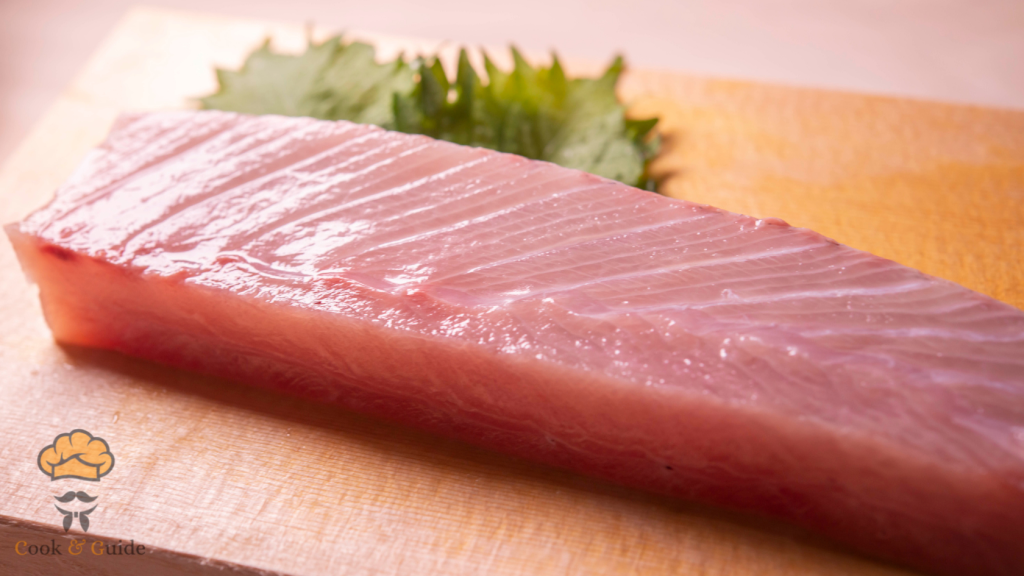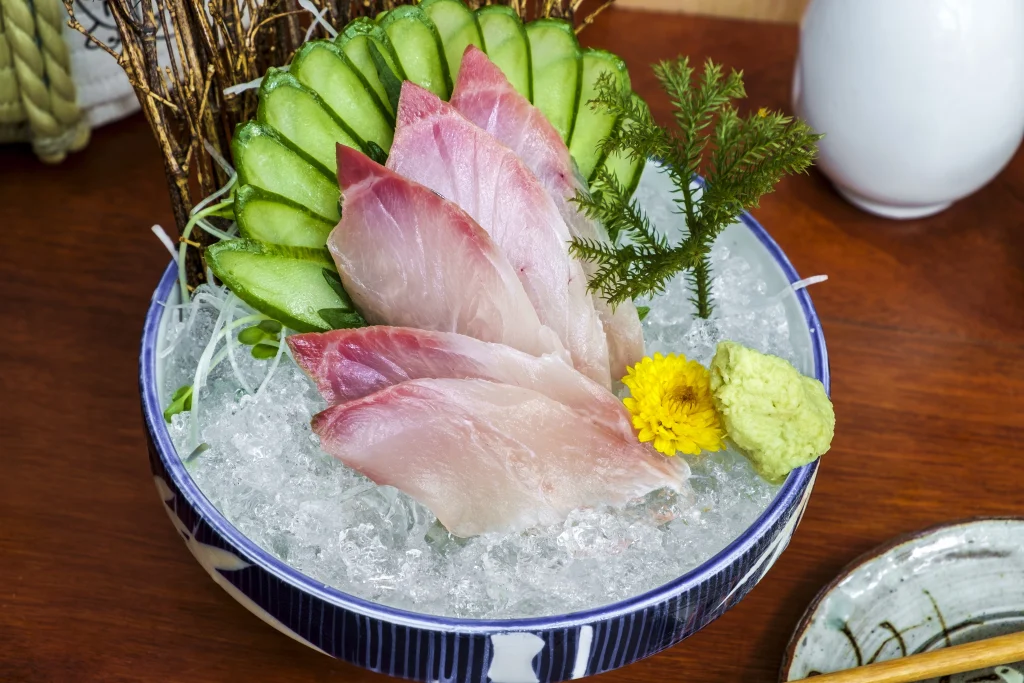Yellowtail Sashimi | How To Make Yellowtail Sashimi | Perfect for Beginners
Yellowtail sashimi is a delicious Japanese dish made from thin slices of uncooked yellowtail fish, known as Buri or Hamachi in Japan, and sometimes called “Japanese Amberjack” in English. The fish is carefully sliced into bite sized pieces and is often served with soy sauce and a touch of wasabi.
Yellowtail is famous for its soft texture and light, slightly sweet taste, making it a favorite among sushi lovers. Caught from the Pacific Ocean, this fresh fish offers a clean, delicate taste with every bite. If you’re just starting to explore Japanese food, yellowtail is an easy and delicious dish you definitely don’t want to miss.

Yellowtail Sashimi Recipe
Enjoy Yellowtail Sashimi’s delicate, buttery flavor. A classy and easy to make dish. This recipe can help you achieve restaurant quality results at home, whether you’re treating family or having an enjoyable meal at home.
Ingredients To Make Yellowtail Sashimi
- Fresh Yellowtail Fish (Hamachi) – 200-300g
- Soy Sauce – For arranging or smother.
- Lemon or Lime – For extra freshness (optional)
- Olive Oil – A small amount for more taste.
- Chili Peppers – For a little spiciness (optional)
- Cilantro or Herbs – For garnish (optional)
- Salt – A pinch for salty
Step 1: Prepare the Yellowtail
- Start with fresh, high quality yellowtail fish. The best option if you’re new to making sashimi is to have a professional at the market clean and slice the fish.
- Gently rinse the fish with cold water, then dry it with tissue paper.
Step 2: How to Cut Yellowtail Sashimi
- Place the fish on a clean cutting board. Using a sharp knife, cut the yellowtail into very thin slices, about 1/4 inch thick. Make sure you cut against the grain of the fish to get the best texture.

Step 3: Yellowtail Arrange On A Plate
- On a properly cleaned plate, arrange the thin yellowtail slices in a circle shape. To improve the dish’s appearance, arrange them in a neat way.
Step 4: Dress the Sashimi
- Apply a small amount of soy sauce over the slices of yellowtail. If you like, you can add a bit of lemon or lime juice to give it a fresh, tangy flavor.
- Add a tiny amount of olive oil for richness, and sprinkle with chili peppers or herbs if you want some extra flavor.
Step 5: Serve and Enjoy!
- Serve the yellowtail without delay. You can have pickled ginger between bites to refresh your taste.
Nutrition Facts for Yellowtail Sashimi
If you enjoy a piece of Yellowtail Sashimi (about 28 grams or one small slice), here’s what you’re getting in terms of nutrition:
| Nutrient | Amount per Serving (28g) | % Daily Value |
| Calories | 41 | 0.0% |
| Total Fat | 1.5g | 2% |
| Saturated Fat | 0.4g | 2% |
| Polyunsaturated Fat | 0.4g | 0% |
| Monounsaturated Fat | 0.6g | 0% |
| Cholesterol | 16mg | 5% |
| Sodium | 11mg | 0% |
| Total Carbohydrates | 0g | 0% |
| Dietary Fiber | 0g | 0% |
| Protein | 6.6g | 0% |
| Calcium | 6.5mg | 1% |
| Iron | 0.1mg | 1% |
| Potassium | 119mg | 3% |
This table shows you what’s in one piece of Yellowtail (28g) in a simple way. It’s low in calories, fat, and carbs, and has some protein, calcium, and potassium to help keep your body strong. Yellowtail is higher in protein, healthy fat, and vitamins A, B1, B2, and D than other fish species.
Why Yellowtail Dish Is So Special
Yellowtail is loved for its smooth, buttery texture and light, delicate flavor. Unlike other raw fish dishes, it’s not marinated or “cooked” with citrus, letting the natural taste of the fish stand out. It’s a great option for those who prefer simple, fresh, and flavorful dishes.
Buri vs Hamachi
“Buri” and “hamachi” are two types of Japanese fish but refer to different stages of the same fish and have different uses:
Buri
This is a fully grown yellowtail fish, 5 years or older. Buri is bigger, stronger and more flavorful than the younger version. It’s often grilled, simmered or used in sashimi. The taste is rich and oily so it’s great for dishes like buri sashimi or buri shioyaki (grilled with salt).
Hamachi
This is the younger yellowtail, 1 to 3 years old. Hamachi is known for its soft and buttery texture and is often served as sashimi or sushi. It’s especially valued for its delicate flavor which is softer than buri.

How to Store Yellowtail Sashimi
Refrigeration
- Wrap tightly in plastic wrap or parchment paper.
- Store in an airtight container or resealable bag.
- Optionally, place on a tray with ice.
- Keep at 32°F to 39°F (0°C to 4°C).
Storage Time
- Use within 24-48 hours for best freshness.
- If over 2 days, it’s safer to cook.
6 Ways to Enjoy Yellowtail Sashimi at Home
Yellowtail sashimi is a delicious, tender fish that can be enjoyed in many different ways at home. Here are six easy and delicious methods for savoring this fresh seafood.
Classic Soy Sauce and Wasabi
I already shared a quick and tasty recipe for yellowtail sashimi with soy sauce and wasabi.” The classic way to eat sushi is by dipping it in soy sauce with a bit of wasabi. The salty soy sauce brings out the fish’s natural sweetness, and wasabi gives it a slight bite. Be careful not to use too much wasabi, so you can still enjoy the fish’s delicate flavor.
Ponzu Sauce for a Citrusy Twist
Ponzu sauce is a good alternate for soy sauce. It’s a blend of orange juice, soy sauce, and a little bit of sweetness. Ponzu sauce gives an attractive and spicy flavor that makes yellowtail sushi taste even better.
Spicy Sashimi with Chili Oil
If you like spicy food, add some chili oil or thin slices of chili peppers to your yellowtail sushi. The spice adds heat that goes great with the buttery fish, making a tasty mix.
Fresh Herbs and Garlic
To add a new flavor and fragrance, you can put thinly sliced garlic, green onions, or cilantro on top of the sashimi. These ingredients boost the flavor without hiding the slight taste of yellowtail. A little drizzle of sesame oil can also add a nutty flavor.
Yellowtail Sashimi Salad
Make a refreshing salad by placing your sashimi on an arrangement of mixed vegetables. Add sliced cucumbers, avocados, and radishes. Then, pour on a light dressing made of soy sauce, sesame oil, and lemon juice. This is a great way to enjoy sushi in a meal that is both satisfying and healthy.
Sashimi Rice Bowl (Donburi)
For an enjoyable meal, put yellowtail sashimi on top of a bowl of warm sushi rice. Add a little soy sauce, sliced seaweed, and a sprinkle of sesame seeds for extra taste. You can also add a raw egg yolk on top for a creamy feel.
Here are six easy tips to help you enjoy high quality yellowtail sashimi at home. Try different ways to eat this tasty fish and see which one you like best!
Yellowtail Sashimi FAQs
What is Yellowtail Sashimi?
Yellowtail sashimi is thin slices of raw fish from hamachi (a type of Japanese fish). It has a smooth, buttery texture and a light, sweet flavor. People often eat it with soy sauce and wasabi. Freshness is very important to its great taste.
Is Yellowtail Sashimi Safe to Eat Raw?
Yes, it’s safe if you buy good-quality, sushi-grade fish. This type of fish is frozen in a way that removes any harmful parasites. Always choose fish from trusted places and make sure it’s fresh and handled properly.
Do You Need to Freeze Yellowtail Before Eating It Raw?
Freezing the fish before eating it raw can help kill parasites. Many suppliers flash-freeze yellowtail to make it safer. Some very fresh fish might be served without freezing, but it’s best to follow safety rules.
What Does Yellowtail Sashimi Taste Like?
Yellowtail has a buttery, mild flavor with a slightly sweet taste. It’s softer and less intense than other fish like tuna or salmon, making it a delicate and smooth option for sashimi.
What Garnishes Go Well with Yellowtail Sashimi?
Common toppings include pickled ginger, radish, and shiso leaves. Some people add modern twists like jalapeño slices, lemon, or garlic to add more flavor and texture.
How Can I Make Yellowtail Sashimi at Home?
Start with fresh, sushi-grade yellowtail. Slice it thinly using a very sharp knife. Serve it with soy sauce and wasabi. For something different, you can add olive oil, garlic, or a citrus sauce like yuzu ponzu.
Can I Use Frozen Yellowtail for Sashimi?
Yes, you can use frozen yellowtail as long as it’s labeled sushi-grade. Freezing makes the fish safer to eat raw. Just make sure it’s thawed and stored properly.
What Are the Health Benefits of Yellowtail Sashimi?
Yellowtail is high in protein and omega-3 fatty acids, which are good for your heart and brain. It’s low in carbs and fat, so it’s a healthy choice for many diets.
How Much Protein In Yellowtail?
Yellowtail contains about 20-25 grams of protein per 100 grams of fish, making it a good source of lean protein.
yellowtail Sashimi Is Appetizer Or Not?
Yes, yellowtail sashimi is an appetizer, often served before the main course, but it can also be a main dish with rice or sides.






